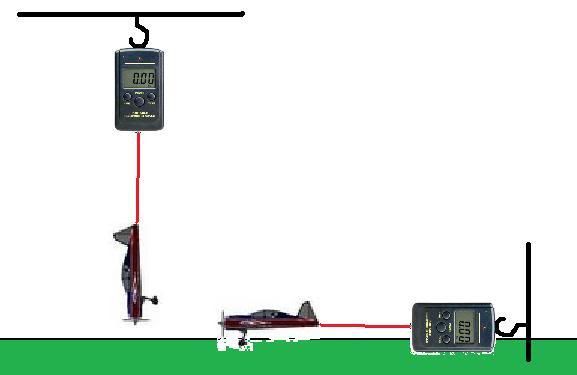|
|
Post by Dillzio on Jun 9, 2010 15:32:57 GMT 1
Hi all, I've been thinking of an easier way to measure thrust than making the conventional thrustmeter rig that we've all seen a million variations of. I was thinking of something that would measure thrust while the motor was on the plane. I've seen you can get some hanging fishing scales off ebay that measure between 10g to 20kg. I was thinking that you could either hang the plane from the scales, and measure the difference in weight when you apply full throttle, or otherwise set it up pretty much the same way horizontally. Here's the two set ups shown in this diagram:  Does anyone think it would/would not work well, and why? -cheers |
|
|
|
Post by Legot on Jun 9, 2010 16:03:29 GMT 1
I think it should work, I'm pretty sure your not the first to do it.
I don't think the verticle one would work correctly, because even if you could calibrate it so that it only measures trust (which you can), I think that it might add more thrust that isn't relivant when horizontl (like in a vertical dive, faster than an unlimited vertical up.
Do you see my point?
|
|
|
|
Post by charliebrown on Jun 9, 2010 16:04:14 GMT 1
Should work very well. I don't see any reason why not.
|
|
|
|
Post by flydiver on Jun 9, 2010 16:20:31 GMT 1
I occasionally do the horizontal method, while a wattmeter is hooked up. It's not as accurate but it's good for comparing props and certainly gives a rough idea of performance. The hard part is securing the tail so you don't damage it on higher thrust systems.
I think the vertical method WOULD be a disaster if something went wrong, the horizontal one COULD be a disaster depending on how close the wall was and your reaction time.
|
|
Matt
Flying officer

Posts: 3 
|
Post by Matt on Jun 12, 2010 2:22:30 GMT 1
Greetings to all, just joined!
A couple things that came to my mind when reading this.. first I think this is a great idea, it'll at least give you your own benchmark to compare different propellers, motors, gear ratios, batteries..etc.
If you can be sure that in the vertical the aircraft will not come unattached, then that should be the best method. In the horizontal, there will be at least some amount of rolling resistance. In the vertical, the forces of gravity and thrust are directly opposing.
Also, remember that the measurement you will get, will be of 'static' thrust. The actual thrust value should be of a higher magnitude at level flight. I bring that up, just to as a thought, that if you get a lower "thrust" value from a different propeller, that does not necessarily mean the propeller will perform less in flight. It could actually give more thrust in flight than another, while measured in a static position. I hope that makes sense.
In any event, it's a great idea. And flydiver has some good safety issues mentioned. Be sure everything is secure, you don't want to damage hardware while doing measurements.
Good luck!
|
|